Drainage pumps for water: types, design, operating features
Drainage pumps are indispensable assistants in solving many problems related to water transportation.Thanks to their compact dimensions and ease of installation, these “universal soldiers” will help you quickly cope with any problem - from pumping unclean water from a well to draining an area.
In order for the unit to cope with the tasks assigned to it, and for the purchase to justify itself with uninterrupted operation, it is necessary to carefully approach the issue of choosing a device.
We will tell you how water drainage pumps work and which models are appropriate to use in a given situation. In addition, we will identify reliable equipment manufacturers and list the main criteria for choosing drainage pumps.
The content of the article:
Drain pump design
The design of any drainage pump, whether domestic or foreign, has a similar configuration and general operating principle. An electric motor with a pump unit is placed in the unit housing.
The working elements of an electric motor are the stator, rotor and bearing shields. The leading working “organ” is mounted on the rotor shaft - a centrifugal impeller, called an impeller.
The pump unit has suction openings. The diameter of these inlet holes determines the maximum size of solid particles that the device can pass through.
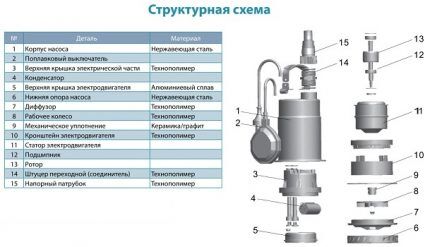
To ensure safe operation of movable mechanisms, the pump unit of the unit is equipped with:
- thermostat – turns off the device when the engine warms up until a critical temperature is reached;
- float switch – reacts when the level of the processed liquid drops to a critical value.
A float switch is a set of sensors enclosed in a sealed polymer box. Thanks to the air inside the box, it, like a float, is always on the surface of the water and moves following its level.
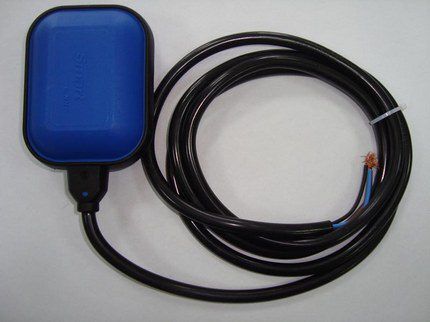
Today, you can increasingly find devices equipped with new aquasensor technology. They are effective when it is necessary to equip narrow tanks, in the cavity of which there is placement float switch does not seem possible.
Using this built-in regulator, it is convenient to set the desired water level to automatically turn the device on and off. The minimum level can reach a level of only 5 mm.
If the drainage unit is used regularly, rigid pipes are connected to it. In case of periodic use of the pump, flexible hoses are sufficient for connection.
Operating principle of the unit
By pumping out water, a sump pump removes it from a filled tank or flooded room to a nearby structure. In this case, the processed liquid first enters the working chamber, and then, thanks to the created pressure under the action of the pump wheel, it moves towards the outlet pipe.
Thanks to the design of most drainage pumps, in which the impeller has a semi-open design, the units are able to pump large portions of liquid in the shortest possible time.
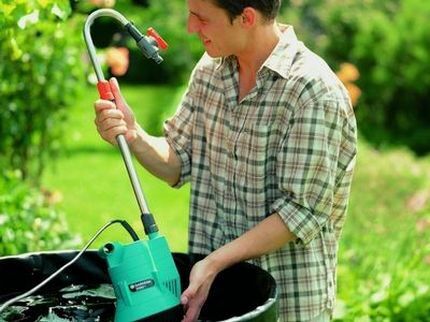
The pumped liquid simultaneously performs the function of cooling the engine. Thanks to this, the likelihood of the pump overheating during prolonged operation is reduced to zero.But for the same reason, drainage pump manufacturers impose restrictions on the maximum temperature of pumped water. For most models it should not exceed 50°C.
There is also equipment on sale that is capable of operating in non-standard conditions and hot environments. But such equipment costs an order of magnitude more.
Drainage pumps are able to operate effectively in environments with varying degrees of contamination.
The units offered for sale are divided into three categories:
- For clean and slightly polluted water. Pump water containing particles with a maximum size of 5 mm. They are used for water intake from water-reducing wells, emptying swimming pools and pumping water from rainwater tanks.
- For moderately polluted waters. The size of solid particles transported with water does not exceed 25 mm. They are used to empty storm drains and drainage wells.
- For dirty liquid with inclusions 38 mm. They are used to empty storage tanks, pumping out dirty water during flooding.
The performance of devices designed for clean and slightly contaminated water ranges from 83 to 230 l/min. And the supply of pumped out liquid can reach from 5 to 12 m.
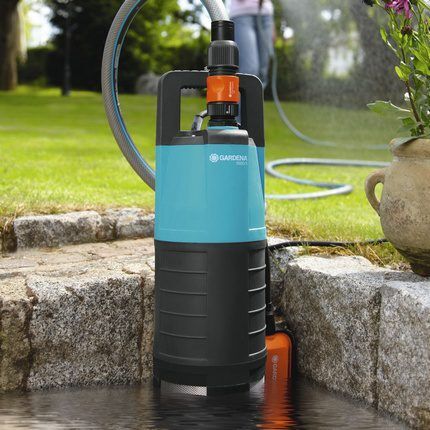
To pump dirty water, including gravel and similar particles with a diameter of 10 to 15 mm, units with a capacity of 37 to 450 l/min are used. They are capable of supplying water to a height of 5 to 22 meters.
Industrial drainage models created for working with sewer systems, can “digest” particles up to 120 mm in size.
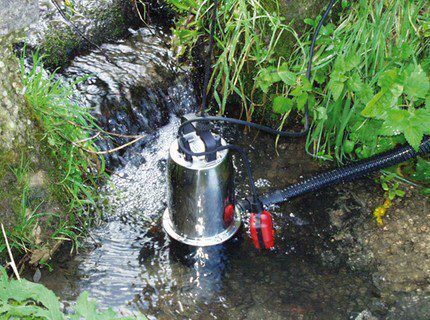
Drainage installations are able to work most efficiently only with liquids that have a minimum content of solid elements.
Contaminated water saturated with solid waste will be dealt with fecal pumps with grinder.
Classification of pumps by type of design
The variety of pumping equipment is divided into two categories: surface and submersible units.
Surface models
Surface units are designed to be installed above a tank. The housing of devices of this type is placed on a flat surface in a dry place. Water is pumped out through a sleeve lowered into the tank: a PVC pipe or rubber hose.
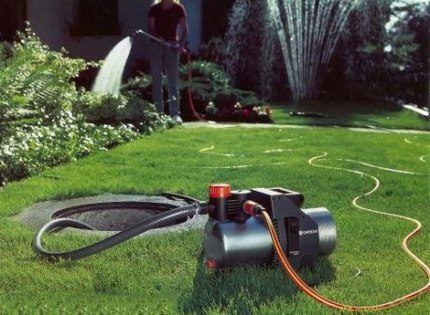
Any surface model has two pipes:
- entrance – ensures the flow of wastewater from a filled container;
- day off – diverts wastewater outside the emptied structure.
Such devices can operate automatically. To implement automatic operation, a float mechanism is attached to the switch on, which responds to the level of liquid in the tank.
It is immersed in the pumped-out liquid along with the hose. When the water rises above a certain mark, the float sensors are triggered, causing the pump to start.
The main advantages of submersible units are:
- ease of installation and dismantling;
- Maintenance of the device comes down to timely cleaning and lubrication of parts.
But such units are not suitable for deep sources. They are designed to operate at a suction height of 8-12 m.
It should also be taken into account that when connecting such a pump to the sewer system, you need to know exactly the cross-section of the pipeline, since the unit is connected to it using pipes.
Submersible drainage devices
Submersible devices operate in almost the same way as surface drainage pumps. But they are more designed for pumping water from deep trenches or well cleaning.
Pumping of wastewater is carried out by the pump itself without the use of hoses and pipes. A mesh filter located at the bottom of the pump protects the unit elements from hard soil, sand and insoluble particles.
The maximum immersion depth of pumps for different models usually does not exceed 50 m. But they cannot be used when emptying small tanks and reservoirs, the depth of which does not reach 20 m. To be able to operate submersible devices in shallow trenches, it is necessary to use additional cooling of the engine with water.
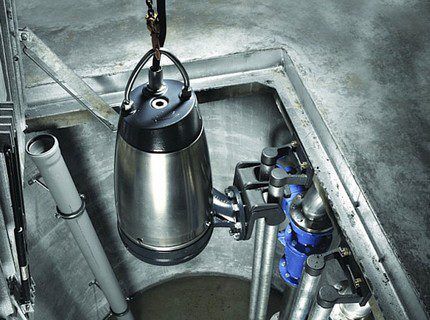
The installation depth of the unit depends on the type of tank. But there is a simple rule: the lower the submersible pump is located, the easier it will be to work with.
Among the main advantages of submersible devices it is worth highlighting:
- high power and productivity in comparison with surface units;
- Possibility of draining deep tanks several tens of meters;
- quiet running — units immersed in a container produce virtually no noise during operation.
A special feature of this type of installation is that it operates automatically. Equipping the device with a float mechanism or a plastic bubble ensures uninterrupted operation of the pump in automatic mode.It turns off the pump motor when the preset water level is reached.
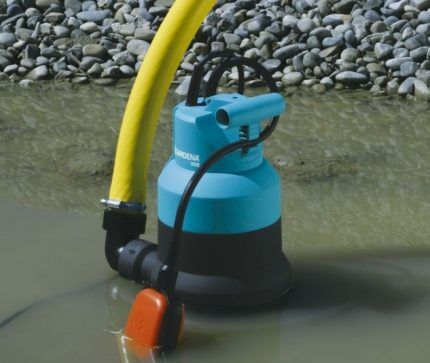
Constant operation of the device under water requires reliable insulation of the automation and sealing of the electric motors of the device. Therefore, in the manufacture of submersible units, only corrosion-resistant materials that can withstand mechanical damage are used.
Depending on the purpose and perceived loads, the manufacturing materials for key parts can be:
- polymers and engineering plastics;
- electrical, alloy and carbon alloys and steels.
In expensive models, seals made of ceramic cuffs or with an oil lock are used to seal the electric motor of the device.
The only disadvantage of submersible devices is that for maintenance and drain pump repair, it has to be removed from the tank to the surface. And due to the tightness of the housing, they are quite problematic to maintain and repair.
Types of pumps by purpose
Depending on the power of the devices and their area of application, drainage pumps are conventionally divided into two types: household and industrial.
Household units
Drainage pumps designed for domestic needs have a wide range of applications.
They are used:
- for pumping water out of flooded cellars and basements;
- emptying technical wells;
- pumping water from swimming pools;
- watering the garden from a pond or barrels.
Single-phase low-power pumps have an average capacity of 800 l/minute and are capable of moving water extracted from a tank, pond, or well to a height of up to 25 m.
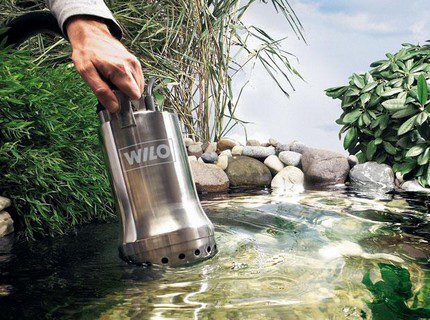
For domestic needs, drainers are most often purchased, the body of which is made of stainless steel or reinforced polymer. They are capable of pumping water containing solid impurities up to 10 mm in size, the ratio of which is 10% of the total volume.
Pumps for industrial purposes
Industrial drainage pumps have higher power and performance. Motor pumps and diesel pump units are widely used by utilities, construction companies and the Ministry of Emergency Situations.
With their help they produce:
- pumping out sewer tanks and clogged pipelines;
- elimination of emergency flooding;
- drainage of industrial waste;
- drainage of collector pits and other objects.
On an industrial scale, drainage pumps are most often used with electric motors placed in cast iron housings. The powerful radiator of such devices ensures effective heat removal, and the cast-iron body protects against deformation during significant heat generation.
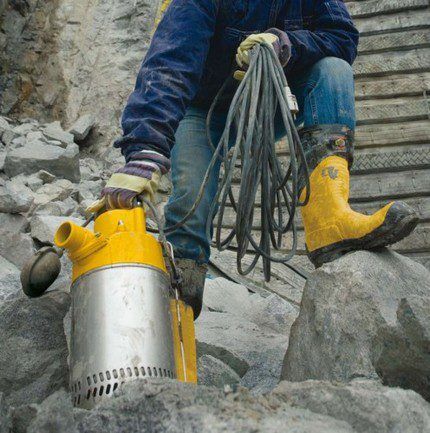
Industrial three-phase pumps are characterized by suction speeds of up to 1500 l/min. They are capable of lifting processed water to a height of about 150 m.
Such models have a more complex design. To carry out maintenance, they require the involvement of a specialist.
Leading manufacturers of drainage pumps
The pumping equipment market today offers a wide selection of drainage units from various manufacturers, both domestic and foreign.
Among buyers, the models produced under the following brands are in greatest demand:
- Grundfos – a Danish company specializes in the production of pumping equipment, including electric motors and components for them. The wide range of models includes both external and submersible devices designed for pumping clean and dirty water of various temperatures. Units produced under this brand belong to the high-price segment, since prices for models are one and a half times higher than the average.
- Perdollo – an Italian company, guided by the principle of helping humanity solve the problems of water supply, produces new generation pumps. The manufacturer's catalog contains hundreds of models, differing in purpose, design and performance characteristics. The wear-resistant and reliable devices they produce, despite their rather high cost, have a lot of positive customer reviews from different parts of the world.
- Wilo – a German brand that appeared on the domestic market more than two decades ago, is famous for the introduction of the latest technologies and modern design. The company produces high-quality equipment for water supply and sewerage systems, as well as ventilation and air conditioning.
The enterprises of each of the listed companies have multi-stage quality control. Their products comply with international quality and safety standards.
Recommendations for choosing equipment
The first thing you should focus on when choosing a unit is the conditions of its use and the degree of water contamination.

When choosing drainage equipment for water, you should focus on the technical characteristics of the product:
- Performance. It is determined based on the amount of work that the unit must perform. That is, how much liquid it should pump out over a specified time period. The emphasis should be on the most complex process.
- Pressure To determine this parameter, you should know the approximate height and distance over which you plan to transport water. This indicator is calculated as the difference between the mark of the water outlet from the pipe and the immersion depth of the unit.
- Pumped out medium. The maximum permissible size of solid inclusions to be pumped with water is specified in the device specification. In models designed to work with contaminated water, the dimensions of the working chamber must be such as to ensure the unhindered passage of fractions.
- Maximum temperature threshold. When choosing a submersible model, focus on the maximum temperature threshold of the pumped liquid, since the engine of such a unit is cooled by transferring thermal energy into the transported liquid. In most cases, the maximum water temperature threshold is 50°C.
The maximum productivity of household units is 180 l/min. This is quite enough to drain the tank or remove water from the cellar.To be able to pump water from the bottom of a container or well in optimal mode, choose models whose suction holes are located at the bottom.
When calculating the required power, you should take as a basis the parameter that one meter of vertical water intake will correspond to ten meters horizontally.
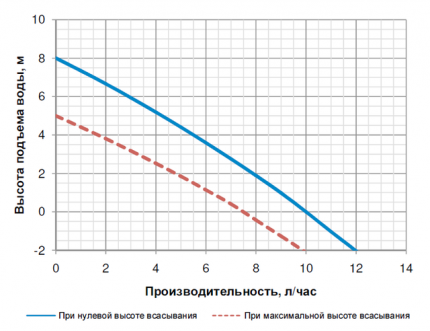
When choosing a model, also take into account the condition of the surface where the equipment will be placed. It is better to place a surface drainage pump in a pit measuring 40x60 cm. This will prevent water from spreading over a flat surface.
If you use automation, which assumes a vertical position of the float, then the surface will remain completely dry. After all, when configured correctly, the float mechanisms work properly and reliably.
Regardless of the type of model designed for pumping clean liquid, it should be taken into account that it should not be used near the silty or sandy bottom of a reservoir. Particles entering the device will clog it, which can negatively affect the service life of the unit.
Additional information on the design features of drainage pumps and advice on choosing equipment is provided in this article.
Conclusions and useful video on the topic
Operating principle of drainage equipment:
Rules for choosing a drainage pump correctly:
Classification of drainage pumping equipment:
A drainage pump is a universal technique that can perform several tasks.By choosing the model wisely, you can use one pump in several processes, which will give you an excellent opportunity to use the unit for a long time and fruitfully.
Looking for an efficient and reliable water sump pump? Or do you have experience using such installations? Please leave comments on the article and share your impressions of using drainage pumps.




I can talk about Grundfos brand pumps, as I have experience using them, the Unilift KP 150-A1 model. The pump is not cheap, but it is very reliable and durable, which is facilitated by the presence of a metal casing. Moreover, it is very productive. At the same time, it is also quite economical in energy consumption, one of the best among its class. True, it also has a minus - you need to separately purchase a check valve.
Without a drainage system, I’m like without hands, because every year, twice a season, my basement is flooded, and there are shelves with all sorts of things, preparations for the winter, etc. I can only save myself with a pump. The only thing that is depressing is the low quality of the filters. I have a budget model and, apparently, only budget nets are produced for it. Large fractions deform them; I change them about once a season. I recommend that everyone who has the same problem with basements consider purchasing a drainage system - it really helps.
Tell me a normal drainage pump for pumping dirty melt water from the basement. Preferably inexpensive.